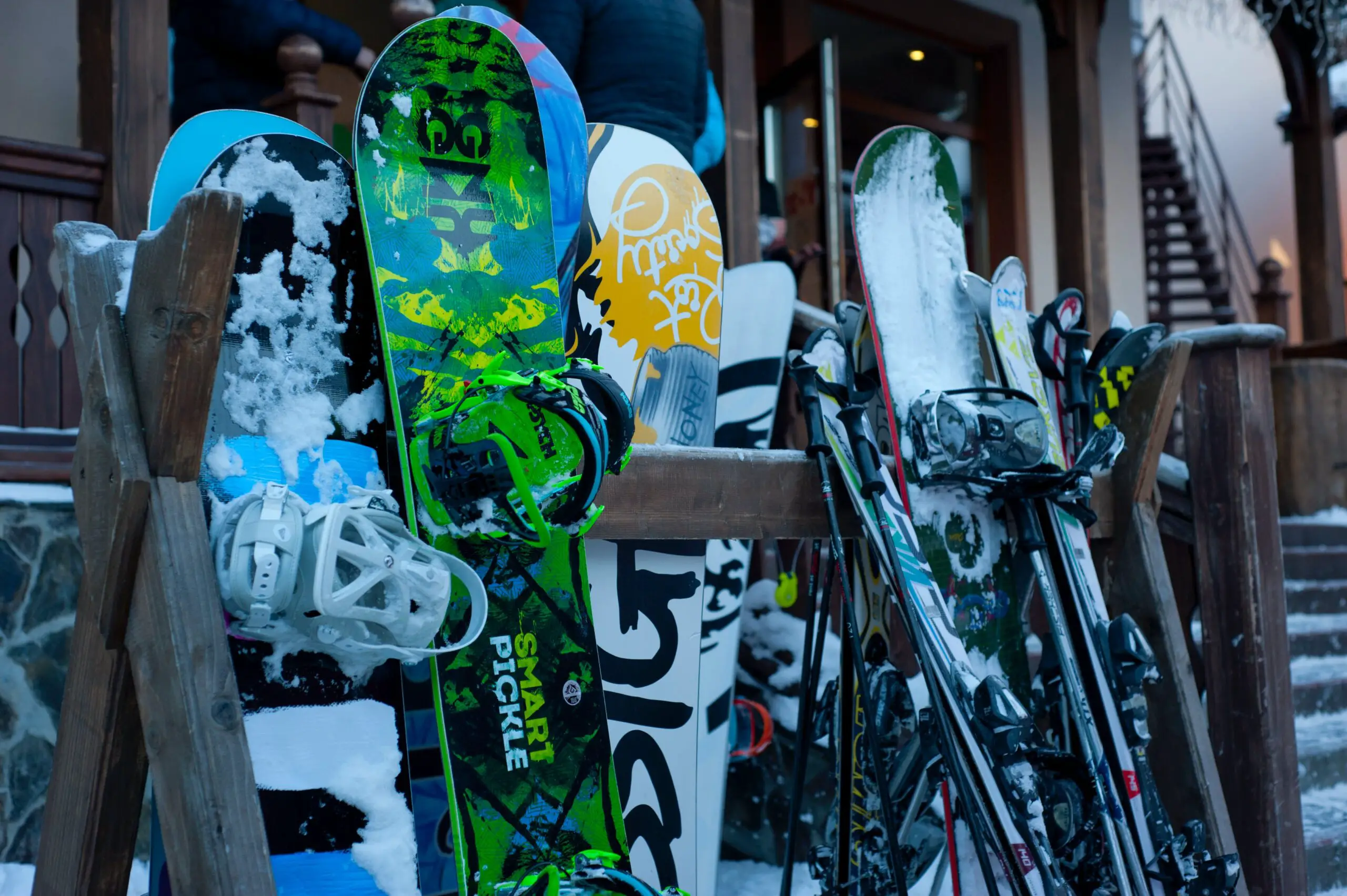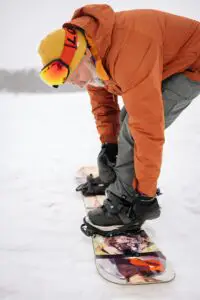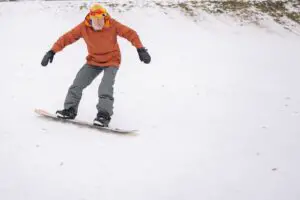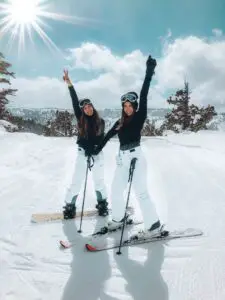Ready to conquer the slopes? Having the right snowboarding gear can definitely up your game. This guide covers everything from choosing the perfect snowboard to understanding key specs for bindings and boots.
Whether you’re a seasoned pro or a newbie, the right equipment can truly enhance your snowboarding experience. Let’s explore the world of snowboarding gear together!
Snowboarding Needs for Different Rider Types
As you progress in your snowboarding journey, your equipment needs change with your skill level. Whether you’re a beginner, an intermediate rider, or an advanced snowboarder, the gear you use greatly influences your performance and safety on the slopes.
Understanding the specific needs of different rider types helps you make informed decisions when selecting snowboarding equipment for your skill level and riding style.
Beginner Snowboarding Gear
When starting out in snowboarding, choosing the right gear is crucial for progress and enjoyment.
A flexible and maneuverable snowboard is essential for beginners.
Supportive and comfortable boots, secure bindings, and protective goggles are also important.
Additionally, a helmet is non-negotiable for safety on the slopes.
Investing in gear suitable for your skill level ensures a positive learning experience.
Intermediate Rider Equipment
When upgrading snowboarding gear for intermediate riders, there are a few key components to prioritize. First and foremost, bindings with adjustable highbacks and straps should be at the top of the list. These features allow riders to customize the fit and feel of their bindings, ensuring maximum comfort and performance on the slopes.
Next, investing in quality boots is essential. Look for boots with a medium flex, as this will offer improved control and stability at higher speeds. This increased control and stability not only enhances the overall riding experience but also aids in progression.
Gear for Advanced Snowboarders
When gearing up as an advanced snowboarder, it’s crucial to have specialized equipment that matches your skills and riding style.
High-quality snowboard goggles enhance visibility and protect your eyes.
Base layers regulate body temperature and manage moisture for comfort.
A durable, waterproof jacket keeps you dry and warm, while insulated and waterproof gloves ensure dry and warm hands.
Lastly, high-performance boots offer excellent support and responsiveness for maximum control while riding.
Choosing the Right Snowboard
When choosing a snowboard, there are several factors to consider. First, think about your riding style. Are you more into freestyle tricks and jumps, or do you prefer carving down the mountain? Your riding style will help determine the type of snowboard that suits you best.
Next, consider your skill level. If you’re a beginner, you’ll want a snowboard that’s forgiving and easy to control. As you progress, you may want something more advanced that allows for greater speed and maneuverability.
Terrain preference is another important factor. Do you primarily ride on groomed runs, or do you venture into the backcountry? Different snowboards are designed for specific types of terrain, so it’s important to choose one that matches your preferred riding environment.
Lastly, take into account the available brands and technologies. Some brands are known for their expertise in certain areas, such as freestyle or powder riding. Additionally, new technologies are constantly emerging in the snowboarding industry, offering different features and benefits.
All of these factors combined will help you make the perfect snowboard selection for your needs. It’s important to take the time to research and try out different boards to find the one that feels right for you.
Snowboard Types by Style
When choosing a snowboard, consider your skill level, preferred terrain, and riding style.
All-mountain snowboards are versatile, suitable for various terrains and riding styles.
Freestyle snowboards are ideal for performing tricks in terrain parks and halfpipes.
Freeride snowboards excel in off-piste terrain and deep snow.
Powder snowboards are designed specifically for deep powder riding.
Additionally, splitboards are for backcountry touring, and carving snowboards are for precise, high-speed riding.
Understanding your preferred style and the type of terrain you ride will help you select the most suitable snowboard for your needs.
Factors When Selecting a Snowboard
When choosing a snowboard, consider your riding style and preferred terrain. The board’s shape, length, and flex are key factors.
Burton offers a variety of boards for different styles. For freestyle and tricks, a shorter, flexible board may be ideal. If you prefer carving down groomed runs, a longer, stiffer board could be better.
Price is also important, with high-end boards offering advanced features, but quality options exist at more affordable prices.
Ultimately, the right snowboard depends on personal preference, skill level, and budget.
Snowboard Brands and Technologies
When choosing a snowboard brand and technology, consider features that align with your riding style and terrain.
For backcountry snowboarding, seek brands specializing in off-piste boards like Burton, offering directional shapes and specialized cores.
Look for ski binding systems if you prefer ski boot flexibility.
Understanding these features will enhance your snowboarding experience.
Key Specs for Snowboard Bindings & Boots
When selecting snowboard bindings and boots, there are a few factors to consider. First, you need to decide between strap-in, rear-entry, or step-on bindings. Each type has its own advantages and disadvantages, so it’s important to choose the one that suits your riding style and preferences.
Next, you should understand the flex rating of boots. This rating indicates the stiffness or flexibility of the boots. Stiffer boots provide more support and control, while softer boots offer more flexibility and freedom of movement. Consider your skill level and the type of terrain you’ll be riding on to determine the appropriate flex rating for your boots.
Lastly, ensure compatibility between the bindings and boots. This is crucial for a secure and comfortable fit, which ultimately leads to optimal performance on the slopes. Check the manufacturer’s recommendations and guidelines to ensure that the bindings and boots are compatible with each other.
Types of Snowboard Bindings
When choosing snowboard bindings, consider flex for responsiveness and stiffness. Soft flex suits freestyle riders and beginners, while medium flex works for all-mountain riders. Stiff flex benefits aggressive riders seeking precision and control.
Ensure compatibility with your snowboard and boots to avoid issues. Look for adjustable straps and highbacks for a customized fit and enhanced performance.
Snowboard Boot Flex Rating
When choosing snowboard bindings and boots, the flex rating plays a crucial role. It determines the stiffness of the boot, affecting control and comfort on the snow. Ratings range from 1 to 10, with 1 being the softest and 10 the stiffest.
Softer boots (1-4) are suitable for beginners or those seeking a forgiving ride. Medium flex boots (5-7) are ideal for all-mountain riders, offering a balance of support and maneuverability. Meanwhile, stiffer boots (8-10) are favored by aggressive riders and those tackling high-speed descents.
It’s important to match the flex rating with your riding style and preferred terrain, whether it’s groomers, terrain parks, or backcountry adventures.
Compatibility Considerations
When selecting snowboard bindings and boots, consider compatibility for optimal performance and safety. Ensure your boots fit the bindings correctly to prevent discomfort while riding. Match binding size with boot size for a snug and secure fit.
Check that the flex rating of your bindings matches the flex of your boots for optimal control. Consider the binding type and ensure it’s compatible with your boots for a seamless fit and performance.
Understanding these compatibility considerations will help you make informed decisions when selecting snowboard equipment, ensuring a more enjoyable and safe riding experience.
Must Have Snowboarding Protective Gear
Before hitting the slopes, essential protective gear is a must.
A snowboard helmet safeguards your head from impacts and falls, while high-quality goggles protect your eyes and enhance vision on the snow.
These accessories ensure safety and improve performance while snowboarding.
Snowboard Helmets for Safety
Snowboarding safety relies on wearing a snug, comfortable helmet to protect your head during falls or collisions. Consider helmets meeting safety standards like ASTM F2040 or CE EN1077.
Look for features like built-in ventilation and audio compatibility to enhance comfort and safety on the slopes.
Goggles for Performance Vision
When selecting goggles for optimal vision and safety while snowboarding, there are several factors to consider. Firstly, prioritize impact-resistant lenses to shield your eyes from debris and UV rays. This is crucial for protecting your eyes from any potential hazards on the slopes.
In addition to impact resistance, a comfortable fit is essential. Goggles that fit properly will prevent shifting during your snowboarding session, allowing you to focus on your performance without any distractions.
Another important aspect to consider is wide peripheral vision. Goggles with a wide field of view will enhance your awareness on the slopes, allowing you to see any obstacles or other snowboarders coming from the sides. This is crucial for maintaining safety while snowboarding.
To ensure clear vision throughout your snowboarding experience, look for goggles with anti-fog technology. This will prevent the lenses from fogging up, even during intense physical activity.
Lastly, consider goggles with interchangeable lenses. These lenses can be easily swapped out to adapt to varying light conditions. This versatility will elevate your snowboarding experience, allowing you to see clearly in different weather conditions.
Budgeting for Snowboard Equipment
When budgeting for snowboard equipment, consider cost-saving packages instead of buying items separately. Assess the pros and cons of new versus used gear, including wear and tear, warranties, and potential savings.
Keep an eye out for discounts on kids’ gear, as many retailers offer special promotions for younger snowboarders.
Packages for Cost Savings
Consider purchasing a snowboarding equipment package to save money. Packages offer matching gear, ensuring seamless performance. They’re cost-effective and convenient, providing essential equipment at a discounted price.
Exploring package deals can maximize cost savings and quality gear acquisition for snowboarding.
Buying New vs Used Gear
When choosing snowboard gear, the decision to buy new or used can greatly impact your overall cost. New gear offers the latest technology and a warranty for high quality and reliability but comes with a higher price tag.
On the other hand, used gear is a more budget-friendly option, but careful inspection for wear and tear is crucial. Consider the trade-offs between cost and quality to make the most of your snowboarding budget.
Kids Gear Discounts
Looking for snowboard equipment discounts for kids?
Many brands offer special promotions during winter. Check websites for limited-time offers, clearance sales, and sign up for newsletters.
FAQs
Ready to snowboard?
Let’s talk about the essential gear and how to set it up for a seamless mountain experience.
What gear do you need for snowboarding
When snowboarding, having the right gear is essential for an enjoyable experience on the slopes. Let’s discuss the essential snowboarding gear:
- Snowboard: Choose a board that matches your riding style and ability level. Freestyle boards are great for tricks and park riding. All-mountain boards provide versatility for various terrains, and powder boards are designed for deep snow conditions.
- Boots: Invest in well-fitted snowboard boots for comfort and control. Look for boots with good ankle support and a secure closure system.
- Goggles: Protect your eyes with high-quality goggles that offer UV protection and good visibility in varying light conditions.
Must have snowboarding equipment
When snowboarding, having the right gear is essential for a safe and enjoyable experience. Your snowboard is crucial – choose one that matches your riding style.
A well-fitting helmet is a must to prevent head injuries. Goggles with anti-fog and UV protection are vital for clear vision and eye safety.
Invest in quality equipment for a great time on the slopes.
Best snowboard helmets
When selecting a snowboard helmet, prioritize safety and protection for your head to reduce the risk of injury during snowboarding. Look for helmets with safety certification labels like ASTM F2040 or CEN 1077, ensuring they meet safety standards.
Find the most comfortable and secure fit by trying on different sizes and considering features like adjustable ventilation and impact protection technologies.
This way, you can confidently choose a snowboard helmet that prioritizes your safety and protection.
How to set up snowboarding equipment
When setting up your snowboarding equipment, start by securely attaching your boots to the bindings.
Place your boots into the bindings, adjust the straps, and center the bindings on the board.
Ensure your boots provide ankle support and flexibility.
Double-check all screws and bolts are tightened for safety.
Properly adjust your equipment to your stance and riding style for a safe and enjoyable experience.
Always follow manufacturer guidelines and seek professional assistance if needed.
How to put on snowboarding boots
When putting on your snowboarding boots, start by loosening the straps for easier wear.
Consider using a balance board on a stable surface to maintain stability.
Ensure your boots are securely fastened before attaching them to a splitboard. This ensures stability and comfort as you take on the slopes.
How to adjust snowboard bindings
When adjusting snowboard bindings, securely fasten them to the board using appropriate tools. Tighten screws with a screwdriver to ensure firm attachment.
Adjust binding angles to fit your riding stance by aligning with reference stance angles and tightening screws.
Position highbacks for right support without discomfort.
Adjust straps to securely hold boots for a snug fit without cutting off circulation.
Center bindings on the snowboard for even weight distribution.
Always test adjustments in a safe environment before hitting the slopes.
How to measure head size for snowboard helmet
When measuring for a snowboard helmet, use a flexible tape measure.
Place it above your eyebrows and ears, ensuring a snug but comfortable fit.
Note the measurement in centimeters and consult the manufacturer’s size chart for the right helmet size based on your measurement.
This ensures a proper and safe fit for snowboarding.
What are the Popular Snowboarding Destinations?
When choosing a snowboarding destination, consider terrains, elevations, and lodge accommodations.
Popular destinations like Aspen, Colorado, and Whistler Blackcomb in British Columbia offer diverse terrains suitable for all skill levels.
The high elevation ensures optimal snow conditions, and the resorts provide top-notch amenities including comfortable accommodations, dining options, and lively apres-ski scenes.
Whether you prefer a family-friendly resort or a vibrant nightlife, these destinations cater to everyone’s preferences.
Conclusion
Are you prepared to hit the slopes with the right snowboarding equipment for an epic season?
Prioritize safety, comfort, and high-quality gear for lasting performance.





